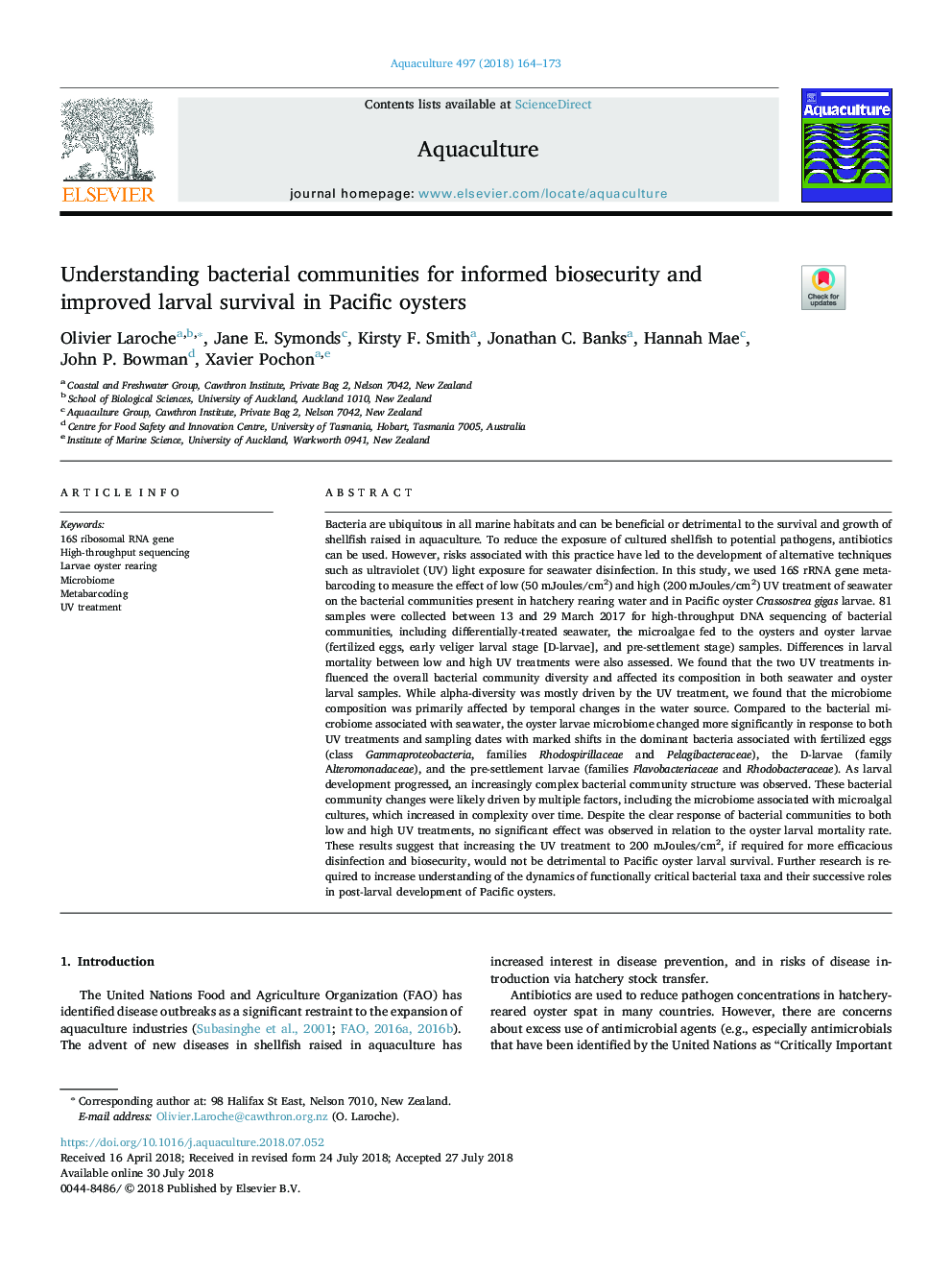| کد مقاله | کد نشریه | سال انتشار | مقاله انگلیسی | نسخه تمام متن |
|---|---|---|---|---|
| 8492982 | 1552791 | 2018 | 10 صفحه PDF | دانلود رایگان |
عنوان انگلیسی مقاله ISI
Understanding bacterial communities for informed biosecurity and improved larval survival in Pacific oysters
ترجمه فارسی عنوان
درک جوامع باکتریایی برای حفاظت از آگاهی بومی و بهبود بقای لاروی در صدف های اقیانوس آرام
دانلود مقاله + سفارش ترجمه
دانلود مقاله ISI انگلیسی
رایگان برای ایرانیان
کلمات کلیدی
موضوعات مرتبط
علوم زیستی و بیوفناوری
علوم کشاورزی و بیولوژیک
علوم آبزیان
چکیده انگلیسی
Bacteria are ubiquitous in all marine habitats and can be beneficial or detrimental to the survival and growth of shellfish raised in aquaculture. To reduce the exposure of cultured shellfish to potential pathogens, antibiotics can be used. However, risks associated with this practice have led to the development of alternative techniques such as ultraviolet (UV) light exposure for seawater disinfection. In this study, we used 16S rRNA gene metabarcoding to measure the effect of low (50 mJoules/cm2) and high (200â¯mJoules/cm2) UV treatment of seawater on the bacterial communities present in hatchery rearing water and in Pacific oyster Crassostrea gigas larvae. 81 samples were collected between 13 and 29 March 2017 for high-throughput DNA sequencing of bacterial communities, including differentially-treated seawater, the microalgae fed to the oysters and oyster larvae (fertilized eggs, early veliger larval stage [D-larvae], and pre-settlement stage) samples. Differences in larval mortality between low and high UV treatments were also assessed. We found that the two UV treatments influenced the overall bacterial community diversity and affected its composition in both seawater and oyster larval samples. While alpha-diversity was mostly driven by the UV treatment, we found that the microbiome composition was primarily affected by temporal changes in the water source. Compared to the bacterial microbiome associated with seawater, the oyster larvae microbiome changed more significantly in response to both UV treatments and sampling dates with marked shifts in the dominant bacteria associated with fertilized eggs (class Gammaproteobacteria, families Rhodospirillaceae and Pelagibacteraceae), the D-larvae (family Alteromonadaceae), and the pre-settlement larvae (families Flavobacteriaceae and Rhodobacteraceae). As larval development progressed, an increasingly complex bacterial community structure was observed. These bacterial community changes were likely driven by multiple factors, including the microbiome associated with microalgal cultures, which increased in complexity over time. Despite the clear response of bacterial communities to both low and high UV treatments, no significant effect was observed in relation to the oyster larval mortality rate. These results suggest that increasing the UV treatment to 200 mJoules/cm2, if required for more efficacious disinfection and biosecurity, would not be detrimental to Pacific oyster larval survival. Further research is required to increase understanding of the dynamics of functionally critical bacterial taxa and their successive roles in post-larval development of Pacific oysters.
ناشر
Database: Elsevier - ScienceDirect (ساینس دایرکت)
Journal: Aquaculture - Volume 497, 1 December 2018, Pages 164-173
Journal: Aquaculture - Volume 497, 1 December 2018, Pages 164-173
نویسندگان
Olivier Laroche, Jane E. Symonds, Kirsty F. Smith, Jonathan C. Banks, Hannah Mae, John P. Bowman, Xavier Pochon,
